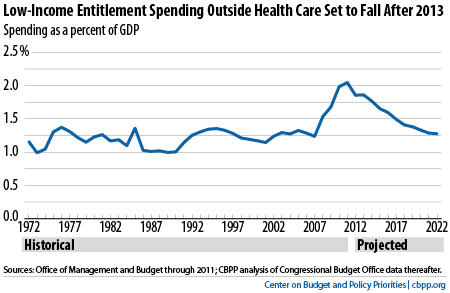BEYOND THE NUMBERS
“Under the current administration, we have . . . seen an explosion in the spending for welfare programs,” House Majority Leader Eric Cantor claimed in support of a new, House-passed rule requiring the annual budget resolution to detail past and projected growth of entitlement programs and propose reforms to them. The rule will “allow us to begin to responsibly control the growth of these welfare programs and ensure they can help those who need them most,” he argued.
But, Rep. Cantor’s statement ignores two key facts:
- First, safety net programs are not a primary cause of the nation’s long-term budget problems. Almost all of the recent growth in low-income entitlement programs is due either to the recent recession — and is therefore temporary — or to rising costs throughout the U.S. health care system, which affect costs for both private insurance and public health programs like Medicaid.
- Second, federal spending on low-income entitlement programs other than health care will shrink significantly as a share of the economy after 2013 (see graph), according to the Congressional Budget Office (CBO).

To be sure, Medicaid is projected to continue growing as a share of the economy, as costs continue to rise across the public and private health care sectors. But Medicaid isn’t the cause of this system-wide cost growth. In fact, per-beneficiary costs have risen more slowly in Medicaid than in private insurance and are expected to continue doing so.
Ultimately, we will need to find ways to reduce health care cost growth in both the public and private sectors. Cost growth has slowed in the past few years, though it is unclear whether the change is temporary or here to stay. Thanks to health reform, however, we are testing new ways to deliver health care designed to lower costs while improving the quality of care that could help slow costs throughout the U.S. health care system over the long run.
The new House rule requires the budget resolution to track growth over the previous decade and the projected growth in the years covered by the budget resolution (often a decade) of two groups of entitlement programs: those focused on low-income people, such as SNAP and Medicaid, and those not just focused on low-income people, such as Medicare and Social Security.
The rule may obscure more than it illuminates: CBO projects that low-income entitlements including health care will grow both in inflation-adjusted dollars and as a share of the economy in coming years; but if you remove health care costs, the picture is entirely different, with low-income entitlements outside health care falling over the next decade as a share of the economy and in inflation-adjusted terms.
If the data that the new House rule requires obfuscate this fact, then the rule could be misused to bolster the false claim that low-income entitlement programs are out of control.
